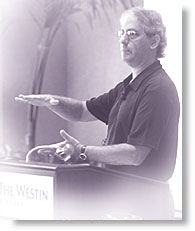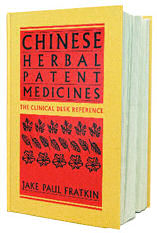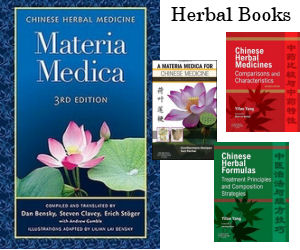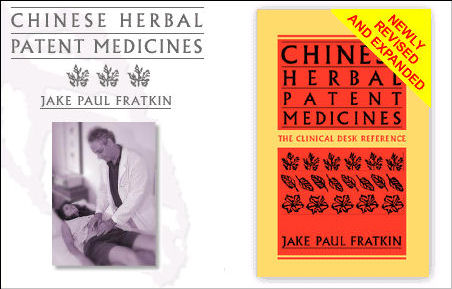Acupuncture & TCM Articles

Articles by Jake Paul Fratkin, OMD, LAc
Jake Fratkin, OMD, LAc, has been in the practice of Oriental medicine since 1978. Following undergraduate and graduate training at the University of Wisconsin in Chinese language and philosophy and pre-medicine, he pursued a seven-year apprenticeship in Japanese and Korean style acupuncture with Dr. Ineon Moon and a two-year apprenticeship in Chinese herbal medicine with Drs. Zhengan Guo and Pak-Leung Lau in Chicago. He also spent a year in Beijing hospitals interning in advanced herbal medicine, specializing in gastrointestinal and respiratory disorders, and pediatrics.  Dr. Fratkin is the author of several books, including Chinese Herbal Patent Medicines: The Clinical Desk Reference, and is the editor-organizer of Wu and Fischer's Practical Therapeutics of Traditional Chinese Medicine. In 1999, he was named the "Acupuncturist of the Year" by the American Association of Oriental Medicine.
Dr. Fratkin is the author of several books, including Chinese Herbal Patent Medicines: The Clinical Desk Reference, and is the editor-organizer of Wu and Fischer's Practical Therapeutics of Traditional Chinese Medicine. In 1999, he was named the "Acupuncturist of the Year" by the American Association of Oriental Medicine.
Chinese Herbal Patent Medicines: The Clinical Desk Reference
Hardback book, 1198 pages. This volume covers 1360 products, including 550 GMP level products and all of California FDB analysis on 505 products. Includes information on endagered animals, heavy metals, and pharmaceuticals. The text is organized into 12 groups, with a total of 109 chapters and includes material by Andrew Ellis, Subhuti Dharmananda, and Richard Ko. Over 80 pages of full-color photos (with English and Chinese cross-reference). Fully indexed.
Treating Viral Infections with Plum Flower Products
The Failure of Antibiotics.
One of the great contributions Chinese medicine offers the West is the availability of herbs and herbal formulas that directly attack viral heat toxins causing the common cold, influenza, upper respiratory infections, and common pediatric diseases. Here, Western medicine is at a total loss, offering at best bed rest and fluids, and at worse, antibiotics.
Why do I say worse? Antibiotics are ultimately ineffective against viral infections, doing nothing to alter the time frame of an infection, but they can negatively impact the body´s immune system. Antibiotics destroy five hundred species of beneficial gut bacteria and promote the growth of the fungus Candida Albicans. Gut bacteria do the lion´s share of enzymatically destroying toxins in the small intestine, as well as providing co-factors that allow absorption of essential nutrients from the food. When they are reduced, intestinal toxins accumulate and malnourishment follows. When Candida is allowed to proliferate, caustic aldehydes are released from the fungus irritating and shrinking small intestine epithelium, allowing absorption of the accumulating toxins. The results are catastrophic, causing a weakened immune system with an inability to effectively fight common infections. (A more complete discussion of this topic can be found in my article, LEAKY GUT SYNDROME, available on the web at http://www.gsdl.com/news/leakygut.html).

American medical doctors persist in prescribing antibiotics for viral infections because they have nothing else they are willing to give to patients. The medical community in this country frowns on the use of herbal or homeopathic treatment, although 50% of German and French medical doctors offer natural medicines. Fortunately in this country patients can turn to practitioners of Chinese or naturopathic medicine, or they can self-medicate from products that are available in natural food shops or herbal pharmacies. A number of Chinese herbal products exist that effectively combat viral heat toxins.
Historical Perspective.
Chinese society has a long history of turning to herbal formulas to clear heat and resolve toxins (qing re jie du). The earliest descriptions can be traced to the Shang Han Lun (220 CE) when Zhong Zhongjing described the six progressive stages of pathogenic factors moving into the body. In 752 CE, Wang Tao formulated Huang Lian Jie Du Wan (MW#3321) to fight toxic infections associated with traumatic blood poisoning. In the 13th century, Luo Tianyi formulated Pu Ji Xiao Du Yin (UNIVERSAL BENEFIT TEAPILLS, MW#3377) to treat fever, sore throat and swollen lymph glands in an epidemic we now suspect as diphtheria.
In the 18th century two excellent formulas were published that directly addressed viral infections. Wu Qian, in 1742, recorded Wu Wei Xiao Du Wan (FIVE FLAVOR TEAPILLS, MW#3332) for boils, carbuncles, and breast mastitis. Later, in 1798, Wu Jutang recommended Yin Qiao Wan (YIN CHIAO JIE DU TEA, MW#4495) for common cold and flu, and pediatric fevers with rash that we now call measles, chicken pox, or rubella.
In this century, several popular patent medicines have gained fame for their strong antiviral effect: GAN MAO LING (MW#3955), CHUAN XIN LIAN (MW#3910), and ZHONG GAN LING (MW#??).
The Materia Medica.
While western herbology offers several antiviral herbs such as Echinacea and Taraxacum (dandelion), the Chinese herbal materia medica has eighteen strong medicinal herbs to destroy pathogenic viruses. Modern clinical research in China has validated their efficacy against the viruses that cause common cold, influenza, measles, mumps, rubella, respiratory, encephalitis, meningitis, herpes, and hepatitis. These eighteen are:
Lonicera Jin Yin Hua, Forsythia Lian Qiao, Taraxacum Pu Gong Ying, Isatis Ban Lan Gen, Isatis Da Qing Ye, Houttuynia Yu Xing Cao, Viola Zi Hua Di Ding, Pulsatilla Bai Tou Weng, Patrinia Bai Jiang Cao, Dictamnus Bai Xian Pi, Belamcanda She Gan, Lygodium Hai Jin Sha, Oldenlandia Bai Hua She She Cao, Ilex Mao Dong Qing, Andrographis Chuan Xin Lian, Smilax Tu Fu Ling, Evodia San Cha Ku, and Lasiosphaera Ma Bo.
When we evaluate the appropriateness of an herbal formula in fighting a viral disease, one benchmark is the inclusion of one or more of the herbs listed above. For upper respiratory viruses causing sore throat, ear infection or nasal congestion, for example, we would expect to see Lonicera Jin Yin Hua and Forsythia Lian Qiao, the two main herbs in the Yin Qiao formulas. For viruses in the lymphatics or the liver, important herbs include Taraxacum Pu Gong Ying and Isatis Ban Lan Gen.
Although not discussed in the classical literature, certain herbs have emerged in the last fifty years as particularly effective against viruses. Modern clinical experience validates the effectiveness of Ilex Mao Dong Qing, Andrographis Chuan Xin Lian, Evodia San Cha Ku, Houttuynia Yu Xing Cao, Pat rinia Bai Jiang Cao, and Viola Zi Hua Di Ding.
Clinical Application of Chinese Herbal Products.
A number of Chinese herbal products exist to treat viral infections. The clinician chooses a product based on stage of the infection, location, and severity. In traditional Chinese medicine, viral infections are divided between attack of heat toxin, or heat toxin sitting and brewing, that is, latent heat toxins that have become symptomatic as the wei qi weakens.
Attack of heat toxins usually happen following pathogenic wind heat. This pattern begins as a sore throat and easily moves into nasal congestion and muscle aching. At this point, viral heat toxins have not yet become severe. The medicine of choice here is YIN QIAO JIE DU WAN (MW#4495). Besides employing herbs to clear heat and resolve toxins (Lonicera Jin Yin Hua and Forsythia Lian Qiao), other herbs clear heat from the surface and channels (Mentha Bo He, Lophatherum Dan Zhu Ye and Soja Dan Dou Chi ). Arctium Niu Bang Zi is specific for sore throat.
Yin Qiao Jie Du Wan is very helpful if taken within the first 18 hours of a wind heat presentation, and is an effective preventative when the slightest symptoms of scratchy throat or headache appear.
If pathogenic wind heat is not cleared quickly, heat toxins begin to grow and accumulate within the lymphatic fluids and tissues (literally re du yun fu, heat toxin brewing and sitting). I believe this is what Zhong Zhongjing meant when he described the shaoyang stage of half-exterior and half-interior in the Shang Han Lun (220 CE). Heat toxins accumulate in the lymphatics because the immune system (wei qi) has been weakened by pathogenic wind or other factors, or because the heat toxins are strong and have overwhelmed the immune system. In this event, one chooses herbal products with stronger antiviral action. Five very good choices exist, all containing strong antiviral herbs. It is interesting that these products do not use any of wind heat clearing herbs, as are found in Yin Qiao Jie Du Wan.
GAN MAO LING (MW#3955) is perhaps the most useful product when a common cold is developing beyond the help of Yin Qiao Jie Du Wan. Here, the symptoms of sore throat, sinus congestion, muscle aching, headache or slight fever are pronounced. Almost 70% of this formula consists of three herbs, Ilex Gang Mei Gen, Evodia San Cha Ku, and Isatis Ban Lan Gen. These three very powerful antiviral herbs have received a fair amount of attention by Chinese researchers and clinicians. Supportive herbs include Vitex Man Jing Zi and Chrysanthemum Ju Hua to clear nasal and eye congestion.
ZHONG GAN LING (MW#??) contains the antiviral herbs Ilex Mao Dong Qing, Verbena Ma Bian Cao and Isatis Ban Lan Gen (59% of the formula). Pueraria Ge Gen (27%) relaxes stiffness of the neck and shoulders causing head and neckache. The original product from Meizhou City Pharmaceutical Manufactory raised concerns because it contained the western pharmaceutical aminopyrine, which can actually damage white blood cells. It also contained 22 ppm of mercury, a toxic heavy metal. The Plum Flower version is clean.
CHUAN XIN LIAN (MW#3910) is an effective three herb combination for infections of the throat, lymph glands, or liver. It´s formula is Andrographis Chuan Xin Lian (50%), Taraxacum Pu Gong Ying (25%), and Isatis Ban Lan Gen (25%). Andrographis Chuan Xin Lian was not mentioned a great deal in the classical herbal texts, but again, modern research and clinical application has elevated it as a preeminent antiviral herb. This particular product is very good for severe sore throat, and I would also recommend it for acute hepatitis.
FIVE FLAVOR TEAPILLS (MW#3332) is the Plum Flower version of Wu Wei Xiao Du Wan, formulated in 1742 by Wu Qian. The original formula was used to treat skin boils and mastitis, and modern clinical use has seen it applied in a variety of viral infections including tonsillitis, measles, chicken pox, mumps, hepatitis, and influenza. Given its herbal composition, I think it is very useful for viral infections in the lymphatic system and the liver. It consists of equal parts of Lonicera Jin Yin Hua, Chrysanthemum Ye Ju Hua, Taraxacum Pu Gong Ying, and Viola Zi Hua Di Ding, with a smaller amount of Begonia Zi Bei Tian Gui.
UNIVERSAL BENEFIT TEAPILLS (MW#3377) is Pu Ji Xiao Du Yin, created by Luo Tianyi during the Yuan Dynasty (1271-1368). This large and complicated formula (14 herbs) was devised to fight diphtheria, an epidemic disease that causes fatal swelling of the throat. It was also used for influenza marked by swollen lymph glands and sore throat. It employs antiviral herbs (Forsythia Lian Qiao, Isatis Ban Lan Gen), heat clearing herbs (Scutellaria Huang Qin, Coptis Huang Lian), herbs to infiltrate the lymphatics (Bupleurum Chai Hu, Scrophularia Xuan Shen, Cimicifuga Sheng Ma), and a two herb combination to directly treat sore swollen throat (Lasiosphaera Ma Bo and Arctium Niu Bang Zi). Clinically, it is helpful for flu or common cold marked by swollen lymphatic glands and sore throat. I often use it in young children with chronic swollen neck lymph glands who get sick easily.
These six formulas offer an excellent arsenal for treating viral infections, whether they be mild or serious, acute or chronic. I believe that 80% of the infections medical doctors prescribe antibiotics for are actually viruses, and the awareness of the availability of these products would greatly reduce antibiotic damage to the individual while raising the overall health and immunity of society in general. The antiviral Chinese herbal products are truly one of the great contributions of Chinese medicine.
 
|
